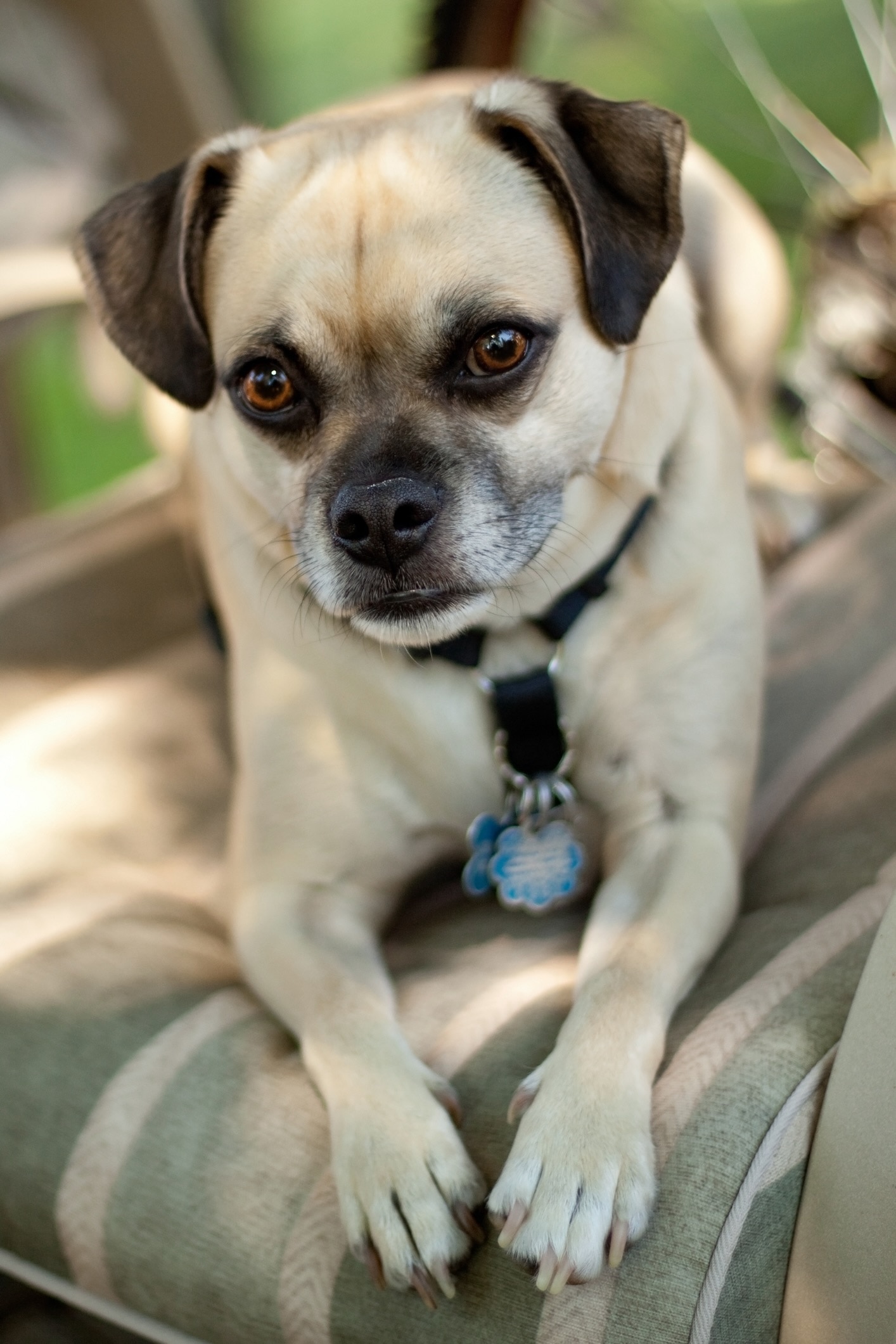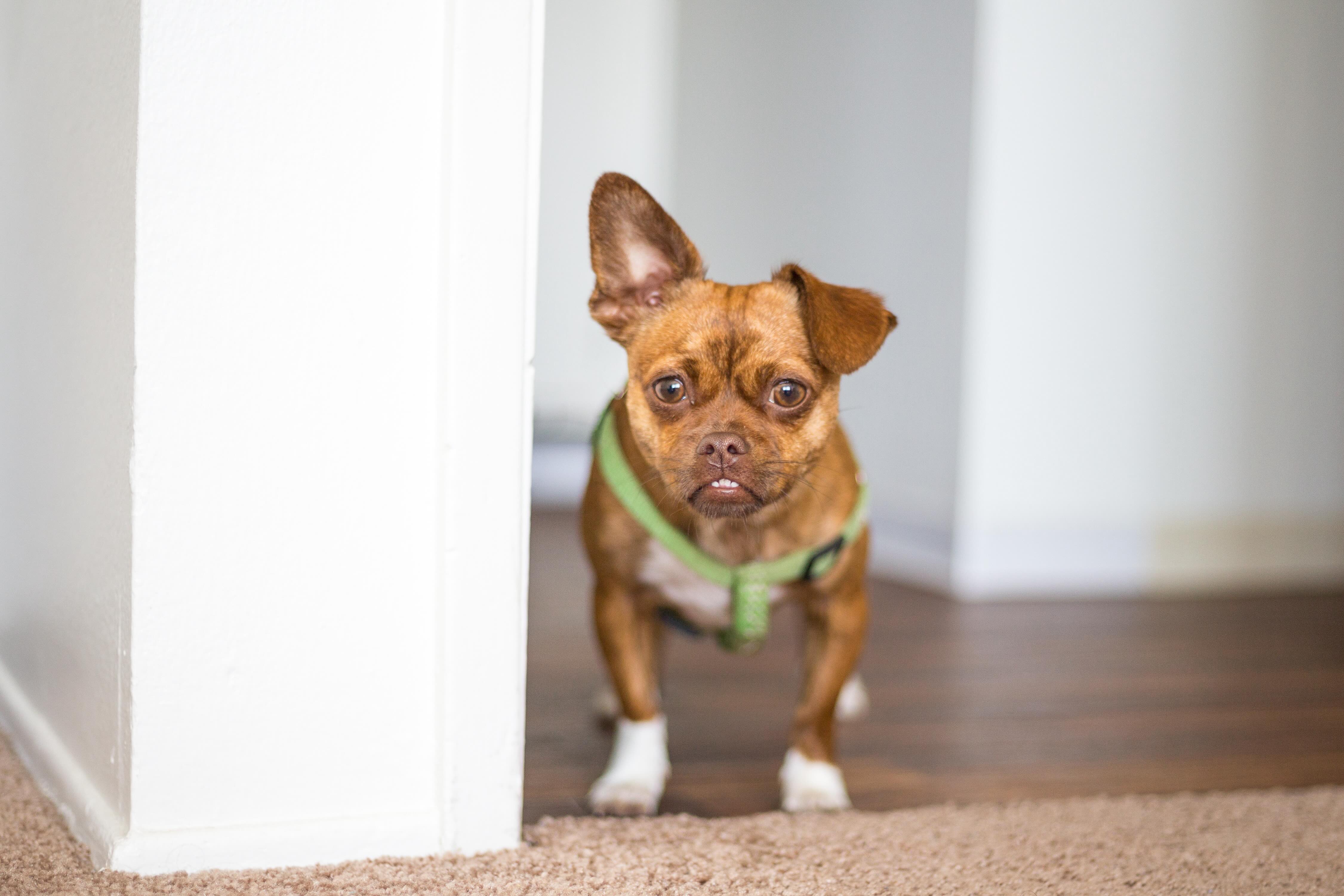Chug
Adobe Stock/Kateryna
The Chug dog breed is a Chihuahua mixed with a Pug. Sometimes called a Pughuahua (or Pugwawa), the Chug is a relatively new mix and is not recognized as an official breed by the American Kennel Club (AKC).
Because there’s no official breed standard, the Pug-Chihuahua mix is highly variable in both temperament and appearance. Chihuahuas and Pugs can even be considered opposite in many respects.
For example, Chihuahuas can have a rounded, apple-dome skull, but the Pug’s breed standard describes a skull that is specifically “not apple-headed.” Moreover, Chihuahuas have erect ears, a slightly pointed muzzle, level or scissor like teeth, and can come in any color. Pugs have ears that fold over, a blunt muzzle, a slight underbite, and come in only two colors (black or fawn).
But when these two contrasting canines collide, you can generally expect a charming, spirited, toy-sized Chug that desires your full, undivided attention.
Caring for a Chug
Thanks to their compact size (a full-grown Chug dog will weigh about 18 pounds or less) and moderate exercise needs, Chihuahua-Pug mixes are ideal companions for small-scale spaces like apartments. However, their build and personality require thoughtful accommodation.
Chug dogs get along with people of all ages, but their small stature makes them vulnerable to injury when playing with very young children who may not understand how to handle pint-sized pets with gentleness. Other large dogs in the home can pose a similar problem.
Luckily, their spotlight-loving personality means they’ll thrive in a one-pet home if you’re around enough to give them the attention and lap space they desire. If they favor their Chihuahua parent, your Chug may resort to barking when bored or lonely.
For both of the Chug’s parent breeds, exercise is a daily requirement but must be handled with care. Chihuahuas can easily overexert themselves, and Pugs are brachycephalic dogs, meaning they have a flat face and narrow nostrils and airways that can make breathing difficult. For this reason, extremely hot weather and strenuous exercise are potentially dangerous and should be avoided.
Chug Dog Health Issues

Both the Chihuahua and Pug are relatively healthy breeds with long lifespans of 14–16 years and 13–15 years, respectively. With proper care, pet parents can expect their Chug’s lifespan to fall within these ranges.
Still, like all dogs, the two breeds are prone to various health conditions that can be passed to their Chug puppies.
Obesity
Small, lap-lounging dogs like Chugs can put on weight quickly. Dogs that weigh 20% or more than their ideal body weight are considered obese and are at a greater risk of developing certain diseases, including arthritis and pancreatitis. Ask your veterinarian to help you determine your pet’s ideal weight.
Eye Diseases and Injuries
The Chug’s large, expressive eyes are part of what makes them unique. But they also make the breed prone to problems such as corneal ulcers, glaucoma, cataracts, and chronic dry eye.
Watch out for these signs of disease in your Chug:
-
Eye pain (indicated by pawing at the eyes)
The Chug’s protruding eyeballs are also more vulnerable to injuries like scratches and punctures, and they may even pop out. These incidents should prompt a speedy call to your veterinarian.
Patellar Luxation
When the patella (kneecap) moves outside its normal groove within the femur (thigh bone), this is called patellar luxation (dislocation). The condition is more common in small dog breeds, including Chihuahuas and Pugs. It doesn’t cause a problem in some affected dogs, but severe cases may require surgery.
Signs of patellar luxation include:
-
Limping
-
Bunny-hopping
-
Audible popping or cracking from the knee joint
Periodontal Disease
Periodontal disease, or gum disease, is a progressive condition in which bacteria accumulate in the mouth, causing damage to the dog’s gums, jaw bone, and other tissues. While the disease is common in all dogs, toy breeds are especially prone to the problem.
Signs of periodontal disease range from irritated gums and bad breath to missing teeth and root exposure. Mild cases may only need a professional dental cleaning, while severely affected teeth must be extracted.
Frequent toothbrushing at home (at least three times a week, but ideally every day) and regular professional cleanings are the best way to prevent periodontal disease.
Brachycephalic Airway Syndrome
Brachycephalic (flat-faced) dogs like the Chug’s Pug parent are cute and instantly recognizable, but there’s a lot going on beneath the surface. Brachycephalic dogs are anatomically different, and their narrow nostrils and airways make them prone to respiratory issues.
Signs of brachycephalic airway syndrome include:
-
Exercise intolerance
-
Collapse
If you see your Chug struggling to breathe, seek immediate care. In some cases, corrective surgery may be recommended as a precaution.
What To Feed a Chug Dog
There’s no overall feeding recommendation for Chugs. You’ll need to work with your veterinarian to develop a feeding plan that’s nutritionally complete and balanced for your pup’s age, weight, and health. Even kibble size and shape is important for this mixed breed, thanks to the Chihuahua’s teeny size and the Pug’s elongated soft palate (an abnormality of brachycephalic dogs).
How To Feed a Chug
Chug puppies need frequent meals (three or four a day) to avoid hypoglycemia (low blood sugar). Full-grown Chugs can be fed less frequently—typically two or three times a day. Your vet can help you determine the best schedule for your dog’s age.
Work with your veterinarian to develop a feeding plan that’s nutritionally complete and balanced for your pup’s age, weight, and health. Even kibble size and shape is important, thanks to the Chihuahua’s teeny size and the Pug’s elongated soft palate.
How Much Should You Feed a Chug?
The nutrition label on your dog’s food bag includes a guide that gives a general idea of how much you should feed your dog based on their weight. But for a more accurate recommendation that’s tailored to your specific Chug, ask your veterinarian. Your dog’s weight, body condition score, lifestyle, and health needs will all be factored into determining the right amount of food.
The Chug can be prone to obesity, so remember to factor dog treats into their daily calorie requirements. Treats should never make up more than 10% of your dog’s diet.
Nutritional Tips for Chugs [H3]
If your Chug is eating a complete and balanced diet of dog food approved by the Association of American Feed Control Officials (AAFCO), they’ll receive all the nutrition they need. However, your veterinarian may recommend a supplement or prescription diet to treat or prevent a health condition at some point.
For example, given the parent breeds’ predisposition for periodontal disease, your vet may recommend dental chews as a precaution for your Chug (though chews can’t replace regular toothbrushing!).
Always talk to your veterinary team before adding anything new to your dog’s diet.
Behavior and Training Tips for Chug Dogs
Chug Personality and Temperament

Chugs are a mixed breed, which means their personalities are a mixed bag.
The Chihuahua breed standard notes that they project “the 'terrier-like' attitudes of self-importance, confidence, self-reliance,” while the Pug breed standard highlights the fact that they are even-tempered, stable, outgoing, and loving. And yet, both breeds carry a reputation for being charming, playful, and affectionate family dogs.
Because of their size, Chugs are vulnerable to accidental injuries from young children and large dogs. They do better in homes where they can be the only pet and where children know how to play gently.
Despite being playful and energetic, Chugs need only moderate amounts of exercise, such as short walks or indoor/outdoor games of fetch, to have their mental and physical needs met each day.
Chug Behavior
Chugs aren’t particularly fond of alone time. They prefer to stay near their family (and command their attention, when possible) and may experience separation anxiety when left alone.
Without enough daily exercise and social interaction, bored Chugs with energy to spare can resort to barking (their Chihuahua parent is especially adept at this talent) and destructive activities to fill their time.
Chug Training
It’s important to safely expose your Chug puppy to various animals, people, environments, activities, and objects during their first 16 weeks of life. This is a crucial learning period for them, and socializing your puppy can help them feel comfortable in a wide variety of settings. Ask your veterinarian to share age-appropriate socialization activities.
Chugs are intelligent, loyal, eager-to-please dogs, but they can also be independent and mischievous. A positive, rewards-based training approach has the triple benefit of teaching necessary skills, building the human-animal bond, and providing mental and physical exercise.
If you use treats as a reward during training, factor them into your dog’s daily calorie count. Play, dog toys, and other things your Chug enjoys can also be used as “treats” for good behavior.
Fun Activities for Chugs
-
Walks
-
Obedience training
-
Skills training
-
Fetch
Chug Dog Grooming Guide
Both of the Chug’s parents are relatively low-maintenance breeds when it comes to grooming. However, if your dog takes after their Pug lineage, you’ll need to be prepared for above-average shedding.
Skin Care
The Chug’s Pug parent is prone to skin problems thanks to their characteristic wrinkles, which can trap moisture and dirt. If your Chug has facial folds, spread them apart and clean them with a damp washcloth or pet-safe wipes daily.
Coat Care
The Chug’s smooth coat needs minimal maintenance. A thorough brushing once or twice a week will keep their fur clean and healthy. Ask your veterinarian how often you should bathe your Chug. Bathing too often can strip your dog’s skin of healthy oils, causing dryness and itchiness.
Eye Care
Both Chihuahuas and Pugs give bold, prominent eyes to their puppies, and these eyes are vulnerable to problems. Watch for signs of injury or disease and contact your vet if you notice any changes in your dog’s eyes or vision.
Some eye discharge is normal and can be periodically wiped away with a clean, wet washcloth.
Ear Care
Pugs are prone to ear infections, so their Chug offspring may also be predisposed. Talk to your veterinarian about how you should clean your dog’s ears, how often, and what veterinary products to use. Set up an appointment if you notice any signs of an ear infection.
Considerations for Pet Parents

Here are some questions to consider before adding a Chug to your family:
-
Can I provide a safe environment for a toy-sized dog?
-
Can I share my home with a dog who might shed a lot?
-
Can I brush a dog’s teeth daily (or at least three times a week)?
-
Am I home enough to give a dog companionship?
-
Do I have the time to provide a dog with mental and physical exercise every day?
-
Do I have the skills and patience to train a dog, using positive reinforcement?
-
Am I financially prepared to provide veterinary care?
-
Can I provide a dog with a loving home for their lifetime, which could be 16 years or more?
If you can answer these questions with an enthusiastic “Yes!” you may be ready to parent a Chug.
Chug Dog FAQs
What is a Chug dog?
A Chug dog is the playful, pint-sized offspring of a Chihuahua and a Pug.
Are Chug dogs healthy?
Chugs are generally healthy dogs, but like all dogs, they will inherit disease predispositions from their parents. Chugs are particularly prone to conditions such as obesity, periodontal disease, brachycephalic airway syndrome, and eye problems.
How long do Chugs live?
Chugs have an average lifespan of 13–16 years.
How much is a Chug puppy?
Chug puppy prices can vary, but you can generally expect to pay $500 or more for a Chihuahua-Pug mix. Do your homework to ensure the breeder prioritizes dog health over profits. You may also be able to find a Chug through a rescue or shelter organization.
